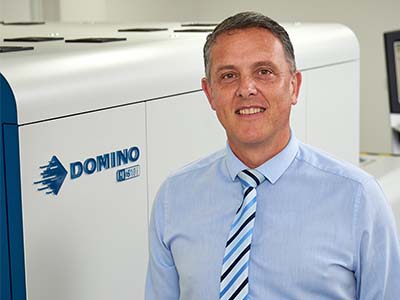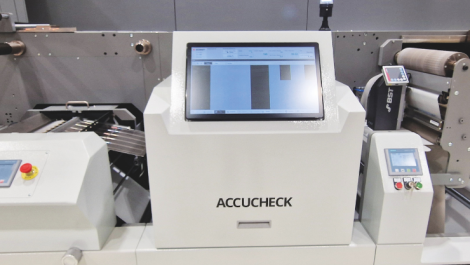Interview with Ian Woodhead, managing director of Anglia Labels. By Des King.
Ian Woodhead can rightly claim to be one of the labelling sector’s true digital pioneers, having been operations manager at Kings Town when the Hull-based packaging repro house acquired the UK’s first ever Indigo Omnius press in 1996. That early hands-on experience of doing mock-ups and samples stood him in good stead as the precursor to a digital journey that took him almost 200 miles down the east coast to transform the fortunes of a local business that had been almost as quick to recognise the possibilities of the new technology, but was still stuck on the starting blocks in being able to realise them.
With the installation of anew five-colour Domino N610i UV inkjet pressthis February, it’s a journey that still has plenty of highly productive linear metres to run.
When and why did you extend into digital print?
Anglia had been an early adopter of digital print technology; its Indigo Omnius was only the third to be installed in the UK. However, the company never had the in-house skill-set to realise its full potential until I joined them in 2003, bringing 22 years of reprographic skills and knowledge.
Up until then, Anglia’s core expertise had been as master die-cutters rather than quality printers, running water-based flexo, Sanjo letterpress and Sanjo waterless offset presses. However, the hitherto untapped capability to meet a growing demand from customers for better quality, low volume print runs over multiple variants in shortened lead times gave us the opportunity to make good on that original investment and extend into digital label manufacturing.Within a year, we were producing 25% of total output digitally without having to incur expensive plate and set-up costs.
What were the main challenges you had to address?
As one of the early pioneers in digital label printing, there was tremendous excitement in being ahead of the competition, but the initial journey was bumpy to say the least. Indigo was a good company to work with, but its engineers had spent most of their time on the E-Print flat-sheet presses and so very few had seen the webfed system; in fact we pretty much learnt from each other over the first few months. We often felt quite isolated. It was as if we had the first fax machine and no one else to fax.
And what have been the main gains?
We’ve reduced our dependence within the factory on some of the older presses and improved on our lead times and quality, at the same time reducing our running costs. Fifteen years ago,70% of our business was trade; it’s now 95% direct, with very little sourced via print brokers. Turnover has increased three-fold from £800,000 to £2.4 million. It should top £3 million this year, and I want to be at £3.5 million by the end of next.
Having built on our relationship with HP through the installation of the ws4500 press in 2012, we have very recently extended into inkjet through a five-colour Domino press, which is already accounting for 25% of turnover. We’re running it for around eight hours per day and additionally using it for proofing, as well as a learning facility, so it’s creating sample packs and imaging for the sales team to take out.
The best we get out of our semi-rotary presses is around 30-35m/min so the faster speed from inkjet is a massive bonus. When I first looked at it, I could see that the Domino could output in a week what it’s taking our other six systems combined to produce in a fortnight.
How has customer awareness of digital developed over the years?
I don’t think that much has changed. Digital had been sold for years on quick turnarounds, artwork in and labels printed same day with no plate costs. There has never been a true appreciation of cross-over points if you have an existing cutter, if you have the correct material in the warehouse or other jobs in front of it in the queue. We find that most customers don’t care how their labels are printed. Quality is a given expectation. What drives the majority of our customers is price and delivery.
And how has digital helped you and them to develop your businesses?
We have developed a relationship with all of our customers where a digital print sample can be produced within 24 hours of receiving the artwork on the correct substrate. This enables them to pass the artwork for colour and literals, and their marketers to produce sample mock-ups ahead of the print run, before which the print is signed off so the customer gets no surprises. With the increased frequency of ingredients and regulatory changes as well as monthly promotions, digital print gives us the ability to react appropriately without plate costs and them having warehouses full of redundant labels that can’t be used. We’re now able to discuss print requirements, promotions, stock holding and costs with our customers and support them in a way that secures our relationship going forward.
Looking back is there anything you wish you’d done differently?
I wish we had bought the Domino sooner! It’s a different skill set from electro-photography. It’s also self-cleaning. With the Indigo we probably lose 7 hours out of each 37 hour shift through cleaning and making sure the press is fully ready. That’s like any good partnership; if you don’t look after it then it lets you down. With the Domino we turn it on in the morning, give it 10 minutes to warm up and then we’re off.
Not only is the colour reproduction and quality close to what we were already achieving on both flexo and the HP press, but they are also more vibrant, punchier and clearer. Everything was quality, quality, quality; partly due to the inks, but also the engineering of the printhead. We looked at other inkjet manufacturers, but they weren’t anywhere near as good.
In fact, we were all set to sign with Domino five years ago even though the ws4500 had only been installed for a year. However, we were approached by another local label printing company that had a new UV flexo press and a full order book, but had just lost their sales team and most of the workforce. It made commercial sense to buy their business, but that meant we had to put the Domino on the back burner.
What advice would you give to anyone adopting digital now?
You need to know your markets, your run lengths, your running costs, but also, most importantly, you need to understand that unlike a conventional press that will give you good service for more than 20 years, a digital press will be out of date in far less time. Digital presses will help with short to medium run lengths and can include personalisation, sequential numbering and texture. This in itself opens doors and opportunities to produce different types of print, but still, ensure you look at the price of the ink and make comparisons between flexo and digital.
There has always being a split within the industry as to whether you die-cut inline or offline; there are arguments in favour of both. Do ensure, however, that this is part of your decision-making process. Being able to print at 50m/min is no good if you can only die-cut at 30m/min as you’ll have lost a lot of the advantages of why you moved into digital print in the first place.
How do you see the future for digital print for packaging?
For a while the advances that were being made by HP were so substantial that I then only wanted to stay with them. However, with the likes of Domino, Screen and so on coming onto the market and offering print solutions at a similar quality with greater speeds and without the click charge, my opinion of three years ago is different today. And it’ll probably be different again in three years’ time.
There are things to be learned in this trade every single day, and things that surprise me in terms of quality and enhancement today that will be just the norm in a few years. For example, I never thought we’d be able to put texture down by just using a white ink under the other inks to create a relief effect.
My eyes and ears are always open and I am sure we will all have a different opinion on the way forward for our own companies, digital or flexo, or a combination of the two processes. It will depend on our vision for growth, the markets we are in and the markets we could be in if we take the next risk.






